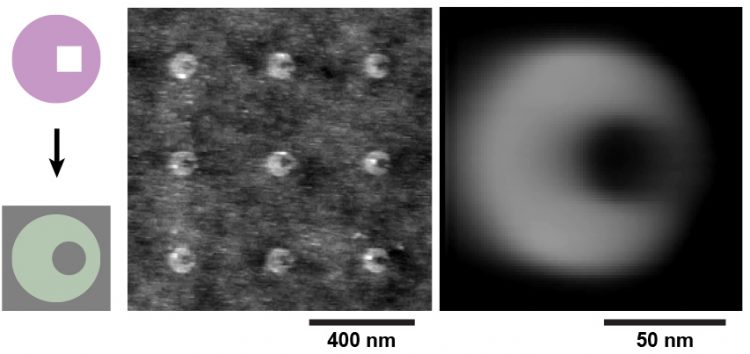Computer chips and other miniature electronic devices are ubiquitous in our daily lives in part because they can be mass-produced using lithography, a method that involves printing components on a flat surface.
Adding nanoscale components, such as biological molecules, to these devices can power new kinds of chips that integrate molecular biosensors with optics and electronics. This could aid applications ranging from DNA sequencing to simultaneously measuring the concentrations of thousands of proteins.
Such devices, however, can be difficult to mass-produce. One barrier has been a reliable way to place a large number of nanoscale components precisely and independently on a surface.
Now a team of engineers, including one at the University of Washington, has developed a technique that allows for the precise placement of molecules formed from folded DNA in not only a specific location but also in a specific orientation. The team published this proof-of-concept project Feb. 19 in the journal Science.
“Previously the folded DNA molecules, which looked like right triangles, were consistently getting ‘stuck’ in the wrong orientations, or multiple copies of the DNA shapes were sticking to the same surface patch. After creating computer simulations and using mathematical techniques, we identified a ‘small moon’ shape that always orients itself correctly,” said co-author Chris Thachuk, a UW assistant professor in the Paul G. Allen School of Computer Science & Engineering.
The research builds on more than 15 years of work by senior author Paul Rothemund, a research professor of bioengineering, computing and mathematical sciences, and computation and neural systems at Caltech, and his colleagues. In 2006, Rothemund showed that DNA could be directed to fold itself into precise shapes through a technique the team dubbed “DNA origami.”
Then Rothemund and team described how DNA origami could be positioned at precise locations on surfaces. To do so, they used a printing process that created “sticky” patches that had the same size and shape as the origami did. The DNA bound precisely at the location of triangular sticky patches.
Next, Rothemund and lead author Ashwin Gopinath, an assistant professor of mechanical engineering at Massachusetts Institute of Technology, extended this technique to demonstrate that molecular devices constructed from DNA origami could be reliably integrated into larger optical devices.
“The technological barrier has been how to reproducibly organize vast numbers of molecular devices into the right patterns on the kinds of materials used for chips,” Rothemund said.
But the technique had an Achilles’ heel.
“Because the triangles were equilateral and were free to rotate and flip upside-down, they could stick flat onto the triangular sticky patch on the surface in any of six different ways,” Gopinath said. “This meant we couldn’t use any devices that required a particular orientation to function. We were stuck with devices that would work equally well when pointed up, down, or in any direction.”
Molecular devices intended for DNA sequencing or measuring proteins absolutely have to be right side up, so this technique would ruin 50% of the devices. For transistors and devices that require a unique rotational orientation only 16% would function.
The first problem to solve was to get the DNA origami to reliably land with the correct side facing up.
“It’s a bit like guaranteeing toast always magically lands butter side up when thrown on the floor,” Rothemund said.
The team first coated origami with a carpet of flexible DNA strands on one side, which enabled more than 95% of them to land face up. But the problem of controlling rotation remained.
The researchers switched to using right triangles with three different edge lengths to create a shape that might land in the preferred rotation. But only 40% of the right triangles would point in the correct orientation.
That’s when Gopinath recruited the UW’s Thachuk and David Kirkpatrick of the University of British Columbia to find a shape which would only get stuck in the intended orientation. The computer scientists’ solution was a disk with an off-center hole, or a “small moon” shape. This shape sticks to a corresponding small-moon shaped patch on the surface.
Mathematical proofs suggested that, unlike a right triangle, small moons could smoothly rotate to find the best alignment within their sticky patch. Lab experiments verified that over 98% of the small moons found the correct orientation.

To highlight this achievement, the team created a polarization-sensitive fluorescent flower where each petal only lights up when stimulated with light of a particular polarization. Each petal is filled with the small moons containing special fluorescent molecules placed specifically perpendicular to the axis of the DNA helices making up the shape. This ensures that all fluorescent molecules in a petal were all oriented in the same direction.
“It’s as if every molecule carries a little antenna, which can accept energy from light most efficiently only when the polarization of light matches the orientation of the antenna,” Gopinath said.
With robust methods for controlling the up-down and rotational orientation of DNA origami, a wide range of molecular devices can now be cheaply integrated into computer chips in high yield for a variety of potential applications.
“What was so fun about this project is that the computer science aspects translated over into robust experimental results exceptionally well,” Thachuk said. “All of these seemingly disparate ideas from different disciplines needed to come together to arrive at this solution.”
Anya Mitskovets and Harry Atwater at Caltech are also co-authors on this paper. This research was funded by the Office of Naval Research, the Air Force Office of Scientific Research, the National Science Foundation, the Orr Family Foundation, the Abedin Institute and a Banting Postdoctoral Fellowship.
For more information, contact Thachuk at thachuk@cs.washington.edu.
Adapted from a release by Caltech.